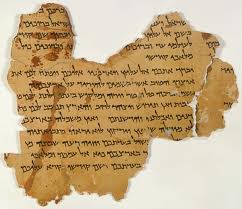 Close Topic Options
Close Topic OptionsDead Sea Scrolls
Dead Sea Scrolls - The Bible Revealed - Posted: 5th May, 2009 - 3:49pm
Dead Sea Scrolls
Recently, I was privileged to tour the Dead Sea Scrolls Exhibit at the San Diego Natural History Museum. If you ever have the opportunity, I highly recommend the experience.
...Exhibition highlights include:
# Authentic Dead Sea Scrolls, fully interpreted with translation of text and background information
# Psalms scrolls containing passages from liturgy still in use today
# The best preserved of all Deuteronomy manuscripts containing the text of the Ten Commandments
# A section of the Copper Scroll from Jordan, the only Dead Sea Scroll inscribed on copper
...
# Authentic artifacts from the ancient site of Qumran, fully interpreted, incorporating the latest scholarship and scientific research
# Modern science at work through DNA analysis, Carbon-14 dating and other scientific methods used to piece together the Dead Sea Scroll puzzle
# Panoramic photography exploring the geographical similarities between San Diego county, Israel and Jordan
To ensure preservation of the 2000-year-old parchment, the Israel Antiquities Authority only allows scrolls to be exhibited for a three-month period. The Museum has been granted the unusual opportunity for a six-month exhibition with 12 scrolls displayed for the first three months and an additional 12 in the last three months. In addition, three Dead Sea Scrolls from Jordan will be on display throughout the course of the exhibition.
Source 9
I went with a friend, as part of a church group of single adults. Most of the experience is actually done "Solo" in that you are given a listening device that is similar to a cell phone, and as you walk through the "Caves," each piece of the scrolls (and other items) has a number that you enter into the device. You then listen to a short narrative as you examine the piece. It took four hours to complete the tour.
What amazed me most was the delicate lettering on each parchment or papyrus - so tiny! - every character perfect, as well as being perfectly aligned. I envisioned that, with the primitive/crude implements used during that era, the actually lettering would be larger and not nearly as neat. However, I learned that because of the scarcity of good parchment/vellum and inks, scribes learned to conserve space by writing small and perfectly - no mistakes, you'll waste it!
We take for granted the accessibility of the written word, we have so many printed books and other documents so easily available to us. Can you imagine the time spent to cure the hides of goats or sheep (not to mention the raising, slaughtering, and skinning), cutting to precise measurements, stitching the pieces together, and then making your own ink from scarce sources? Then you have to spend many, many hours actually writing and writing and writing, oh-so-carefully done.
I have a new appreciation for the sanctity of the Bible and how the words of God were preserved from generation to generation in the time-consuming and tedious process. Those of us who revere these words, we should give great gratitude to the Jews and others who put forth such careful efforts to bring forth the scriptures for our benefit in this time and place.
Go see it! Even if you are not a Bible believer, this is fascinating history.

Dead Sea Scrolls (Hover)
Scrolls Sea Dead
I wish I was closer I would love to go and see it. Best I ever cam was a girl at the local hobby shop. her father helped translate some of the scrolls. Talked to him a bit about it but he refused to comment much on the information but shared the rest of the experience very willingly. Odd part he quit the Catholic church after completing his assigned tasks with the scrolls.
Scrolls Sea Dead
I don't know that you could actually read them, KNtoran, partly because the majority are in ancient Hebrew, partly because the text is so tiny and the scrolls are enclosed in glass cases. They do have reproductions of partial scrolls on the walls next to some of the exhibits, but, again, it's all in Hebrew or maybe Greek. There have been some translations posted around the 'net, but due to deterioration of the scrolls, they are incomplete - apart from some notable exceptions, namely, the entire text of Isaiah!
Very cool.
Not sure where the exhibit has moved on to next. It was only in San Diego for 6 months.
Dead Sea Scrolls The Bible Revealed
This is why I would want a ancient hebrew translation book so that I can read some of the scrolls myself. I would try as I can to see what I could make out of them from behind the glass. I think some of the original meanings were lost in the translations. Reading some older books from ancient times has always been a passion of mine.
 TOPIC: Dead Sea Scrolls
TOPIC: Dead Sea Scrolls
